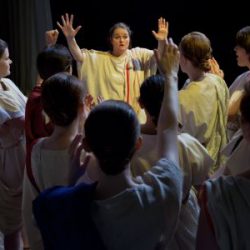It’s well known that professional theatre troupes in Renaissance England included male actors only, so that the roles of, for instance, Juliet, Rosalind, Lady Macbeth, and Cleopatra were first played by boys. This doesn’t mean that women never performed in England at that time. Noblewomen danced in masques at court, and visiting foreign troupes of players or acrobats sometimes included women, although the actresses in one French company were “pippin-pelted” by the audience when they appeared on a London stage in 1629. Overall, though, as Dympna Callaghan puts it, there was a “systematic prohibition against female mimesis” – women were not permitted to act onstage.
Women did attend the theatre in significant numbers, although some commentators considered even this too public a role for women, saying that having women in the audience distracted from the stage performance and incited lewd behavior in men. Lewdness among audience members was one reason English Puritans considered theatre dangerous or sinful: others included the potential for spreading disease and the similarity of play-acting to lying. When, in the English Civil War, the Puritans gained control of London, they issued an order closing the theatres, which then remained closed for eighteen years, from 1642 to the restoration of King Charles II in 1660.
The new theatre patents issued by King Charles said,
forasmuch as many plays formerly acted do conteine severall prophane, obscene and scurrilous passages, and the women’s parts therein have been acted by men in the habit of women, at which some have taken offense…we doe likewise permit and give leave that all the women’s parts to be acted in either of the said two companies may be performed by women…
It didn’t take long for theatre producers to use the permission they had been granted. In 1660, Thomas Jordan revived Othello with, for the first time, a woman playing Desdemona.
Given that, in Shakespeare’s day, all the roles were played by men, Theatre Unbound has returned the favor with our all-female productions of The Tempest, Julius Caesar (an Ivey Award winner), and Hamlet. We’ve also poked a bit of gender-bending fun at the Bard in Goodnight Desdemona, Good Morning Juliet, and asked directors to devise work based on the Sonnets in The Directors’ Gym.
Further reading:
- Brown, Pamela Allen & Peter Parolin. Women Players in England, 1500-1660: Beyond the All-Male Stage (Aldershot: Ashgate Publishing Limited, 2005).
- Callaghan, Dympna. Shakespeare without Women: Representing Gender and Race on the Renaissance Stage (London; New York: Routledge, 2000).
- Orgel, Stephen. Impersonations: the performance of gender in Shakespeare’s England (Cambridge: Cambridge University Press, 1996).
- Prynne, William. Histromatix: The Player’s Scourge, or Actor’s Tragedy (London: 1633).

